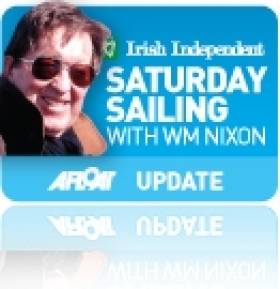Displaying items by tag: Loch Nevis
Mallaig Scottish Fishing & Ferry Port Fights It Out Over the Ablutions Block
A little fishing and ferry port with a small marina on a remote part of Scotland's west coast has recently been grabbing headlines in national newspapers. And it's basically all to do with the row provoked by the need for an ablutions block at the marina. W M Nixon tries to guide us through the twists and turns of this Mallaig mayhem.
Time was when Mallaig was always a place of conflicting interests. This little port, which is on the south side of the entrance to Loch Nevis on the Scottish mainland north of its most westerly point of Ardnamurchan, has odd origins, and an even odder history. As a natural harbour, it was very limited - not much more than a gut in the rocks behind some islets. The locals never gave it much attention. But for the Vikings, it was a very useful sort of place, as they could haul their longships safely into the creek and still be handily poised both to attack other ships on the Sound of Sleat, or go raiding deep into the Scottish mainland or across to the Isle of Skye.
As for a lack of facilities and accommodation ashore, the true Viking lived austerely on his ship. So once they'd finally moved on to settle in places with more natural advantages, Mallaig seems to have been forgotten. While harbours were developed to the south at Oban on the mainland, and Tobermory on the isle of Mull, Mallaig was a blank.
Things changed in the mid-19th Century, when the Scottish highland and islands were still in turmoil with further waves of the "Clearances", which had started in the 18th Century in pursuit of the large landowners' policy of evicting rebellious tenant crofters in order to replace them with much more profitable and manageable sheep. The Clearances seem to have come late to the huge North Morar Estate eastward of Mallaig, with the owner Lord Lovat "encouraging" his tenants in the 1840s to vacate their land among the mountains and move to the western part of the peninsula. There, he was convinced they could make a jolly good living from fishing, and Mallaig's first little pier was built to help them do so, with His Lordship meantime returning to the much more profitable business of sheep farming.
It's a rather drastic method of creating a maritime community, but in time it worked. Doubtless there are useful lessons here for those who would wish to see the Irish people rise up and become gallant seafarers every one. But for the still very small and decidedly primitive port of Mallaig, once they got the hang of the fishing, they needed an outlet for their catch.
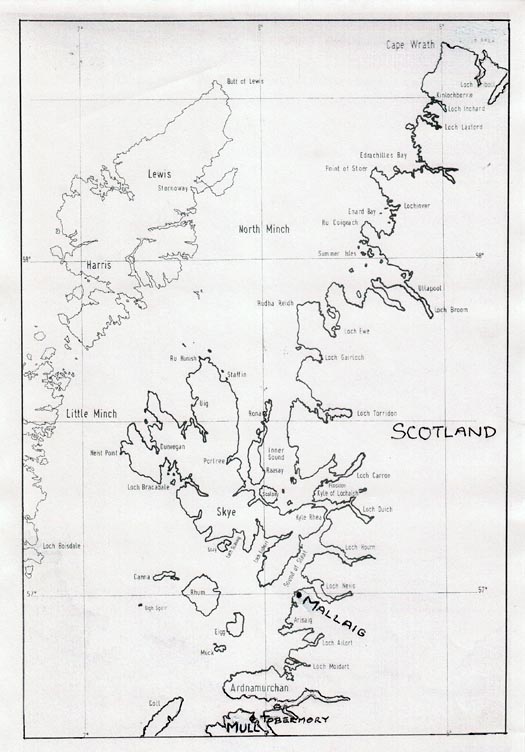
Mallaig's strategic location was attractive to the Vikings, but in modern times it didn't start to develop as a port until the middle of the 19th Century.
The railway arrived in 1901, and it was bonanza time, for this wasn't any old railway, this was the famous West Highland Line, with London at the other end, and umpteen useful towns and cities in between. It brought many benefits, and provided a means of transport which, by the 1960s, had Mallaig rated for a time as the biggest herring port in Europe. The railways took fish out, and brought travellers in – people who were keen to get to the nearest islands as soon as possible. So Mallaig also developed rapidly as a ferry port.
I was first there in 1963, when it was frequently no place for a cruising boat. The total length of quay space was still small, and the conflicting demands for harbour room between the fishing boats and the ferries meant it was a madhouse at certain times. But equally, if you happened to call by after the ferries had sailed, and while the fishing fleets were at sea, it could be pleasant enough, and very useful for effecting crew changes, for the much indented West Coast of Scotland has remarkably few places with such reasonably convenient connection to the outside world.
So it was a place for brief visits, and continuing vigilance on the movements of boats berthed alongside. But restful would not have been an adjective which sprang to mind. Thus for many years, although we transitted the Sound of Sleat several times, we never went into Mallaig. We preferred the islands anyway, and with maturity, the joys of a fishing port at night seemed distinctly limited.
But with maturity, you also find your shipmates can no longer blithely step aboard at the beginning of a cruise, and stay aboard until you get back to the home port. So in cruising Scotland's Hebrides in 2012, at mid-cruise we'd to make sure we were in Mallaig so that a shipmate could catch the 10.10 to Glasgow and home.
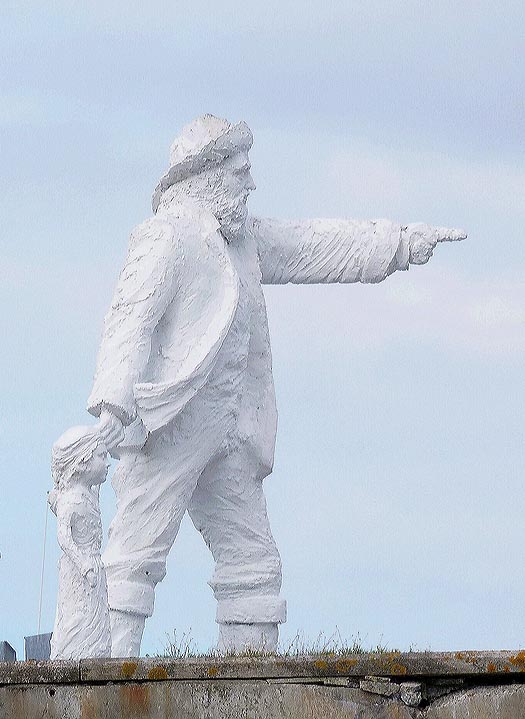
Mallaig's 8ft statue of the fisherman and his grand-daughter was sculpted by Mark Rogers of Knoydart in 2006. Photo: W M Nixon
The place had changed so much it was as though we'd never been there before at all. The harbour was trebled in size, with an outer breakwater to enclose the ferries, and on the pierhead an impressive 8ft statue of a rugged old fisherman pointing seaward, his hand clasped by his tiny grand-daughter.
Later we were to learn that the statue had been crafted in 2006 by sculptor Mark Rogers in his studio on the other side of Loch Nevis in Knoydart, an impossibly beautiful part of Scotland which is so remote that though it's on the mainland, the only access to its pretty lochside village of Inverie is by ferry from Mallaig, of which more anon.

The marina has been inserted at the head of Mallaig Harbour without intruding on other port users. Photo: W M Nixon
But meanwhile there we were, proceeding open-mouthed up a prosperous port with ferries neatly in one area, fishing boats neatly in another, and beyond - wonder of wonders – Mallaig's new little public marina, nicely set up in its own area, yet totally convenient to a town which clearly was enjoying life.
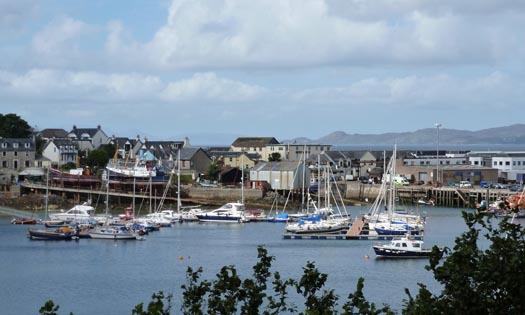
The marina sits cheek-by-jowl with the long-established boatyard, but there is space for both. Photo: W M Nixon
The marina was new as new could be. It had only been officially opened four months earlier, but ever since it had been well filled with cruising boats whose crews had an eye for a strategically useful port which has now, thanks to this secure berthing, become a destination in its own right rather than somewhere you call as briefly as possible to connect with a train or bus.
The timeline for this transformation is fascinating. When we were first in Mallaig in 1963, the place didn't even have a Harbour Authority. No wonder it seemed like frontier territory. It was. It was every man and particularly every skipper for himself. But in 1968, the Mallaig Harbour Authority came into being, by 1972 they'd extended the Fish Piers and built a Fish Sales Hall, then in 1986 the Ferry Pier was extended and with growing demand and new routes to the isles, 1993 saw a Ferry Link Span with RO/RO facilities and land reclamation for extra harbour shoreside space.
But a problem with Mallaig had always been a lack of shelter in northerly gales, so in 1998 a new Outer Breakwater was built, and within it they could accommodate oil storage and delivery systems, while the fishermen also got an ice factory and in 2007 a new Fish Market.
All this is such utterly workmanlike stuff that you can imagine the gruff reaction when somebody raised the possibility of providing a marina. A Yachting Marina, no less. In some determinedly blunt places, you didn't dare use the words "yacht" and "marina". Thus in the rugged fishing port of Ardglass in County Down, one of the most strategically useful and hospitable marinas in all Ireland is still officially known as "The Phenick Cove Boat Park".
But in Mallaig, they took the yachting bull by the horns, and set about researching ways of funding a marina. They were in a good place, and they chose a good time. We can but quote the official documents: "The construction of Mallaig Marina was part-financed under the Sail West project supported under the European Union INTERREG IVA Programme for Ireland, Northern Ireland and Scotland 2007-2013 with co-funding from the Highland Council, Highlands & Islands Enterprise, and Mallaig Harbour Authority."
We were there in August 2012, and it all seemed just right. The secret seems to be to have an authority which has the enthusiasm, energy and intelligence to work the system, and the basic resources to avail of it. You'll note that the particular programme they utilised was in the period 2007-2013. It so happens that all authorities in the Republic of Ireland have been totally preoccupied with cutting back during those precise years, though useful facilities such as the very handy pontoon in Strangford Village in Northern Ireland in 2011 were presumably able to draw on the scheme.
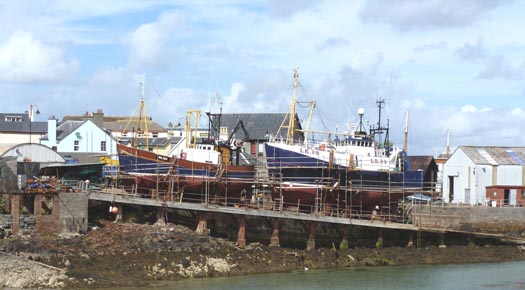
The traditional boatyard adds greatly to the charm of the port......Photo: W M Nixon
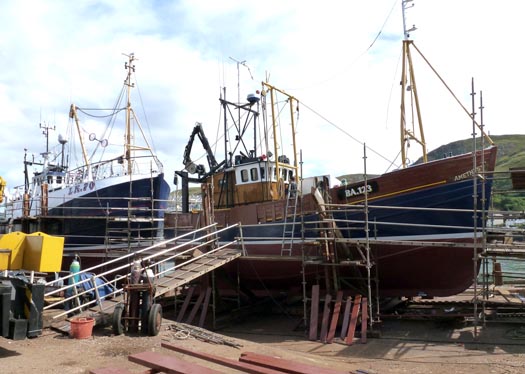
......and is very much part of the town........Photo: W M Nixon
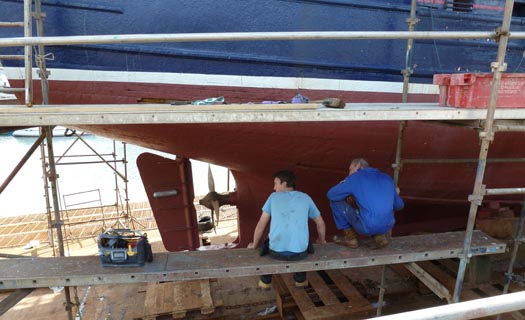
..........yet the work gets done, and there's still time for some thoughtful observation. Photpo: W M Nixon
Whatever, when you're cruising you live for the moment, and we enjoyed Mallaig for what it has become. Not only was the harbour always bustling, but right at the heart of it, overlapping between town and waterfront, was the boatyard, busy as ever, its borders so lightly defined that you could wander in and out through workshops and get a close-up view of a giant propellor (well, "giant" by our standards) being replaced on a fishing boat.
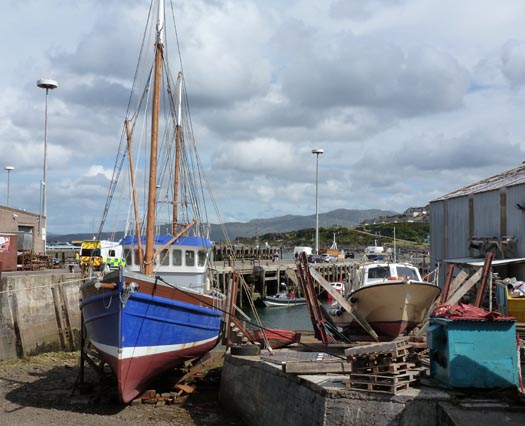
What's not to like about a waterfront like this............Photo: W M Nixon
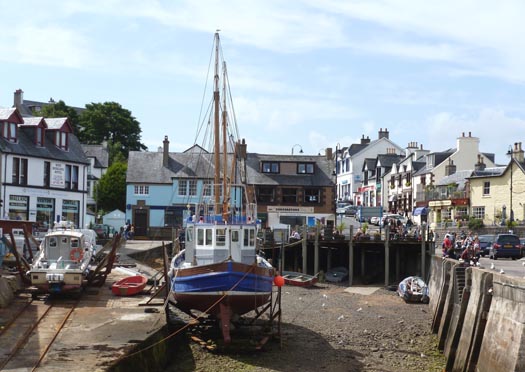
.....where village and harbour intermingle. Photo: W M Nixon
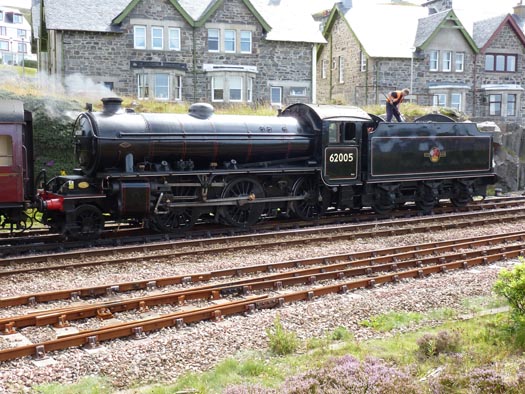
The pride of the line – the mighty steam loco which pulls The Jacobite classic train through the Highlands to Fortwilliam from Mallaig Photo: W M Nixon
Just round the corner was the railways station, and the pride of the line, the mighty steam locomotive to pull The Jacobite vintage train, was in town ready to take a full complement of smokeheads up into the mountains and along to Fortwilliam. It was gorgeous. And as for the feeding the inner man, the basic industrial drinking pubs of yesteryear were long gone, their places taken by an extraordinary variety of establishments, all of them serving good food and drink.
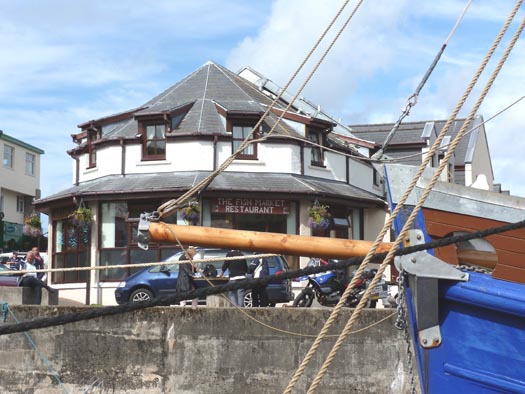
Mallaig is well furnished with eating places to suit all tastes........Photo: W M Nixon
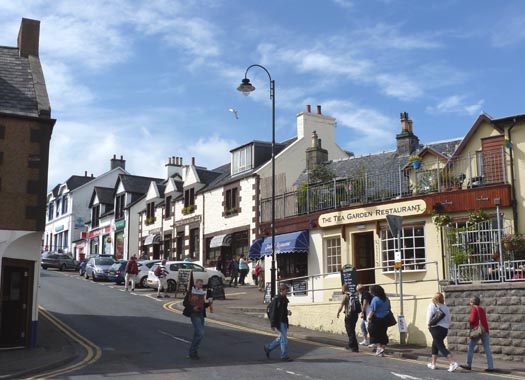
....and close by the harbour, it seems that every other building is a restaurant of some sort. Photo: W M Nixon
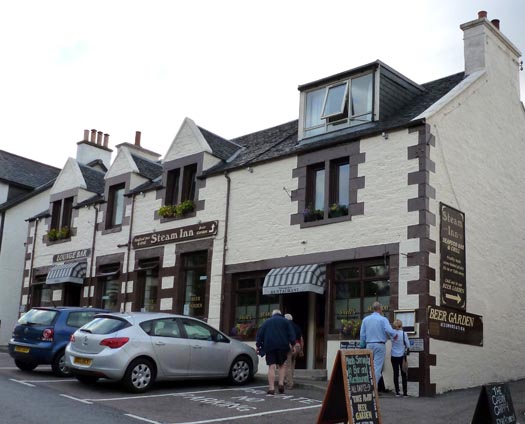
Behind the Steam Inn's modest exterior, there's a powerhouse of culinary creation..........Photo: W M Nixon
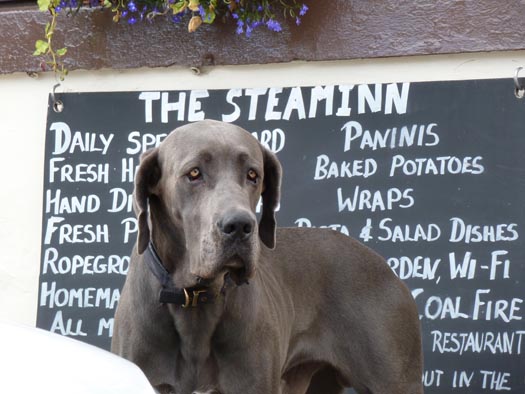
....and the Welcome Hound guides you in. Photo: W M Nixon
Inevitably, thanks to the handsome hound outside, we felt drawn to the Steam Inn where the casual lunch bar menu on the blackboard would put to shame the dinner menu in many a fancier place, but if you happened to feel the need of a fancy dinner, the Steam Inn also had a stylish restaurant with an even more ambitious menu in the evening.
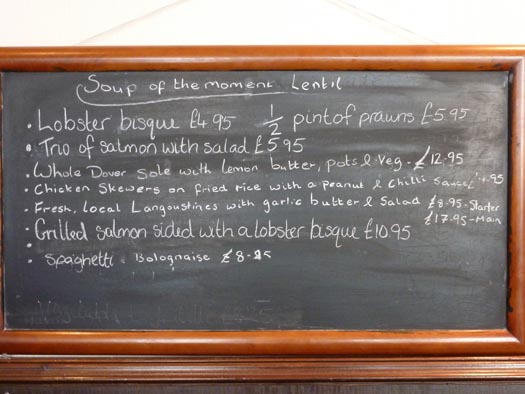
The casual bar menu in the Steam Inn hints at the quality of this award-winning establishment. Photo: W M Nixon
It all sounds like a perfect example of community harmony and a shared purposeful existence. So how has Mallaig leapt into the headlines this past week with a newspaper spat about developments in the village and particularly at the marina?
Well, think show business. You'll remember that we mentioned sculptor Mark Rogers was based in Knoydart on the other side of Loch Nevis, a place so inaccessible that, despite being part of the mainland, it can only be reached by boat from Mallaig?
These days, the owner of the Knoydart estate, which is so big it's probably larger than Luxembourg, is the theatrical impresario Cameron Mackintosh (think Cats, Phantom and Les Mis). So when he wants to get large groups to his Scottish retreat (I'm presuming he uses a helicopter himself), the usefulness of the berthing facilities in Mallaig are important.
Thus the great man has become much exercised about the shoreside facilities at the marina, or the lack thereof. He has offered to lay out £750,000 on building a proper ablutions block provided that he can also include in it a food outlet, for even the greatest theatrical mogul can scarcely contemplate building a luxurious jacks without the thought that it should include additional income streams.

The proposed crannog-style building would provide facilities at the head of the marina bridge on the left of the photo. Photo: W M Nixon
But the thought of an additional food outlet in little Mallaig seems to have struck a raw nerve. Yet as I was saying, we must keep thinking show business, for there has been a certain feeling of orchestration in the subsequent brouhaha. Dutiful journalists have found lively quotes from the good people of Mallaig, and the more easily led of the locals have been induced to make some very rude comments indeed about Mackintosh's seemingly grandiose plans, which have other aspects including demolishing an old village hall to replace it with residential units.
Our hostess at the Steam Inn, the formidable Michelle Milligan, has given forth with all the authority of a Taste of Scotland award winner: "How in God's name is another food outlet going to benefit anyone? You say 'it will provide jobs'. I say I will need to pay off staff as there won't be enough to go around".
Splendid stuff, and it has provided publicity for Mallaig that money wouldn't buy. But lest you think I believe Mallaig is perfect in its current state, it has to be said that a marina ablutions block would be welcome, as the journey to the ancient delights of the Fisherman's Mission for a shower in late 19th Century surroundings is a unique pleasure I would happily do without.
And then there's the matter of taking aboard fuel, a key facility in any self-respecting marina. In Mallaig in 2012, the only place you could buy diesel at marine prices was at the other end of the harbour. That was after finding the man with the key, and getting the nozzle passed through a wire fence to fill the containers which Peter the thoughtful marina manager kept handy, while he also had a designated marina trolley for the diesel trek. If you happened to be outside office hours, you'd still to travel every bit as far to the village garage, and then pay motorists' prices.

The current arrangements for procuring marine diesel in Mallaig are definitely not state-of-the-art. Photo: W M Nixon
So if they won't let Cameron Mackintosh put a food outlet in his new marina block (which he says he's going to build in the shape of an ancient crannog), maybe they should keep his accountants happy by allowing him the concession on a state-of-the-art diesel fuel berth. How would that do on Broadway?
But whatever they let the showbiz greats do in Mallaig, and however inspired their harbour development has been this far, here in little old Ireland we still have Fungie in Dingle Harbour, and he's such a star that he now has a backing group. You'll have seen him and his new friends recently on the Afloat website, and it must be global by now. Wonderful stuff.



























